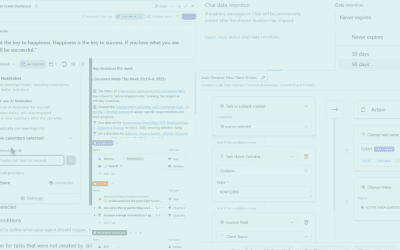
Summary: Your company is about to roll out something new. Maybe it’s a software platform, switching payroll companies, or moving the office to a new location. This is your chance to put structure behind work that’s been duct-taped together for years.
This article is part of the Small Business Project Management Mini-Series. Be sure to subscribe if you don’t already so that you don’t miss any of these insights from top small business project managers.
You’re managing the project internally. No fancy consulting firm. No outsourced PMO. Your own team, your own project managers, are leading the charge. They’re coordinating with vendors, looping in leadership, managing timelines, and trying their best to keep everyone aligned.
Sounds efficient, right?
It can be. But only if your project has the one thing most small businesses skip: process.
Why Projects Fall Apart in Small Teams
In small and midsize businesses, projects often start with good intentions and a lot of hustle. But without structure, even the smartest, most well-meaning team ends up drowning in miscommunication, vague timelines, and dropped balls.
Most internal projects don’t go off the rails because people aren’t doing their jobs. Projects quickly turn into dumpster fires when communication happens late (or not at all), tools get introduced without any shared rules for how to use them, and the human side of the project (aka: the real way this change affects people’s work) is ignored until there’s backlash.
What’s missing isn’t more people, more meetings, or another app. It’s process.
Start Strong: The Project Kickoff
A proper kickoff isn’t just about setting the start date and due date. It’s your chance to set the tone, lock in alignment, and establish processes from day one. Next time you kickoff a project, try the NERD approach:
N is for Need. Every project must start with a clear reason for existing. What pain are you solving? What opportunity are you chasing? If no one can articulate the “why” in a single sentence, it’s going to be hard to get buy-in—or keep momentum when things get tough.
E is for Expectations. This is where most small teams unravel. You can’t assume people know what they’re responsible for, how you’ll communicate, or what the deadlines are. Expectations need to be explicit: who’s doing what, what tools are in play, where files will live, and what the communication cadence looks like. If it’s not written down and agreed upon, it’s not an expectation—it’s a hope.
R is for Results. What does success look like? Not just “the project is live,” but what has actually changed? What can the team or business do now that they couldn’t before? Results help people focus on the outcome, not just the tasks.
D is for Definition of Done. Every project needs a finish line—and everyone needs to agree on where it is. How will you know it’s complete? Who gives the final thumbs-up? Without this clarity, projects drag on with never-ending tweaks and “just one more thing.”
If you skip this, you’re not “saving time.” You’re laying the groundwork for confusion.
Work Planning: Break It Down or Watch It Break Down
Small teams are notorious for skipping the planning phase in the name of flexibility. But flexibility without structure just leads to chaos…quickly.
One of the fastest ways for a project to collapse is to treat it like one giant blob of “stuff to do.” When the entire project is a vague bullet points (or worse, lives in someone’s head), people end up guessing what they’re supposed to be working on – and guessing wrong.
This is where process protects you.
Every project should be broken into clear stages or phases. Within each phase, identify the specific, actionable tasks that need to be completed and who owns them. Don’t assume “everyone knows” what’s included in the implementation phase, or that “marketing will handle it.” Spell it out. If a task doesn’t have an assignee and a due date, it’s a wish list item – not a plan.
This level of clarity isn’t overkill, it’s how you avoid the infamous “I didn’t know that’s what you meant” conversation. It’s how you prevent blame-shifting and backpedaling when things go sideways. And it’s how you stop progress from stalling just because one person was waiting on another and no one said anything.
Defining stages and tasks gives your team a shared map. Without it, everyone’s following their own GPS, and wondering why you all ended up in different places.
Risk Management: Plan for the Fire Drill Before It Happens
Here’s the thing about risk management in small businesses: most people think they don’t need it until it’s too late. They assume, “We’ll deal with it if it comes up.” Spoiler: by the time it comes up, it’s already a problem.
The goal of risk management isn’t to prevent every disaster—it’s to make sure you’re not blindsided when something goes sideways. And it will. Because no project happens in a vacuum. People go on leave. Vendors drop the ball. Leadership priorities shift. Budgets tighten mid-sprint.
Good risk management gives your team a way to respond calmly, instead of scrambling in chaos. Here’s how to make it part of your process:
1. Build a Risk Log (Yes, Even a Simple One)
At the start of the project, gather your team and ask: “What’s most likely to go wrong?” You don’t need a PhD in project management, just list realistic risks.
Examples:
- A key team member is going on vacation or parental leave
- A software license expires before the new system is live
- Your vendor is notorious for delayed timelines
- The team is already at 90% capacity before the project even starts
- Supplies or materials have long lead times and could delay deployment
Then rank them: what’s most likely to happen, and what would have the biggest impact if it did?
2. Create a Plan B for the Top Risks
You don’t need a backup plan for everything, but for the highest-risk items, write down a basic contingency.
For example:
- If [name] is out unexpectedly, [backup person] will step in.
- If the vendor delays again, we’ll cut non-critical features to keep the timeline.
- If tool migration isn’t done by [date], we extend licenses for 30 days.
Now, you’re not just reacting—you’ve already thought it through.
3. Review Risks in Every Status Meeting
Most teams build a risk log, forget about it, then act surprised when something explodes. Instead, revisit your top 3-5 risks during every status meeting. Are they getting more likely? Less? Did a new one pop up?
Flag it. Talk about it. Adjust as needed.
4. Make It a Culture Thing
Risk management isn’t just a PM’s job. Everyone on the team should feel empowered to raise a red flag early—before an issue turns into a crisis. That only happens when risk conversations are normalized, not treated like failure.
Risk management isn’t about being paranoid. It’s about being prepared.
The earlier you identify what could go wrong, the less painful it’ll be when something inevitably does. Because in SMBs, there’s no massive safety net—process is your insurance policy.
Escalation Paths: When the Plan Breaks Down
It’s not a matter of if; something will go wrong. Timelines slip. Vendors ghost. People get sick. So when things go sideways, you need more than just a Slack thread of panicked questions.
Who makes the final call? Who gets looped in? Who’s just being informed? This isn’t about hierarchy—it’s about speed. Clear escalation paths mean decisions can be made quickly, without drama.
This is where an escalation process saves your ass. It doesn’t have to be complicated. It just needs to be clear, quick, and followed consistently.
Here’s a simple 3-step escalation process your PMs can use:
1. Try to Resolve It at the Team Level
Before escalating, make a good-faith effort to resolve the issue with the people directly involved. Clarify expectations, double-check dependencies, and surface any miscommunication. A surprising number of “blockers” are just a matter of someone needing context or clarity.
2. Escalate to the Designated Owner
If the issue can’t be resolved within the working team—or if it’s impacting the timeline, scope, or budget—escalate to the project owner or department lead. That person should be clearly identified in the kickoff. Don’t wait until things are on fire.
3. Loop in Executive Stakeholders When Necessary
If the issue affects strategic priorities, cross-functional alignment, or requires a reallocation of resources, it’s time to elevate it to leadership. Always come prepared with the context, options, and your recommendation. Don’t just drop the problem—bring a possible solution with it.
And remember: escalation isn’t tattling—it’s risk management. It’s how you keep a project moving instead of stalling in endless Slack threads and quiet resentment.
Status Meetings That Keep the Process Alive
Your weekly (or biweekly) status meetings are where the process gets reinforced—or abandoned.
These meetings should be short, structured, and focused on outcomes. Talk about where you are against timeline and budget. Share what was accomplished. Flag issues and risks. Discuss the plan for the upcoming week. That’s it.
Don’t let meetings become progress theater. Use them to spot problems early and keep the team focused.
Change Management: The Process You Can’t Ignore
Here’s the part most teams don’t want to deal with: the human side of change.
The way people do their work is personal. It’s tied to their routines, their habits, their sense of control. Change gets messy when it’s announced suddenly, implemented sloppily, and explained poorly. If you skip the process here, expect resistance, confusion, and whispered Slack threads full of “wtf is this?” energy.
Here’s a simple 5-step framework to approach change management with intention—not just hope:
1. Define & Communicate the Vision
What are we changing—and more importantly, why? What does the future state look like, and what will be better because of it? People need to see the purpose before they’ll buy in.
2. Involve and Empower Key Stakeholders
Don’t roll out a change to people—bring them into the process. Identify team leads or influencers who can flag potential friction points and help bring their people along. When they feel ownership, they’ll help carry the weight.
3. Break the Change into Manageable Steps
Massive, sweeping changes create overwhelm. Break the transition into logical chunks. Tackle one phase at a time, with clear goals and milestones along the way.
4. Provide Training, Tools, and Resources
Don’t assume people will figure it out on their own. Document the process. Create job aids. Run short training sessions. Equip people to succeed instead of setting them up to struggle silently.
5. Monitor, Adapt, and Reinforce
Change isn’t a one-and-done event—it’s a process. Collect feedback. Watch for what’s working and what’s not. Celebrate quick wins, and course correct where needed. Keep reinforcing the new way until it becomes the norm.
Bottom Line: Process Isn’t Bureaucracy, it’s the difference between success and failure
In small and medium businesses, where resources are tight and people wear a dozen hats, process can feel like a luxury. But it’s the opposite.
Process is what keeps projects from becoming disasters.
It keeps communication clear and expectations grounded.
It gives your team a fighting chance to deliver something great—without burning out.
So if your internal team is leading your next project, don’t wing it. Don’t assume everyone’s on the same page. Don’t wait for problems to surface before you build the structure to deal with them.
Lead with process. Finish strong.

Jacqui Myslinski
ClickUp Expert + Project Management Consultant
Jacqui is a productivity nerd with an extreme affinity for details. Her mission is to challenge the status-quo with a relentless pursuit of innovation, creativity, and empathy, so that together we can be more productive, collaborative, and happier in our work and lives.
She’s an experienced Project Manager with a proven track record of delivering successful projects with high client and stakeholder satisfaction (personal NPS of 96). Areas of expertise include waterfall and agile project management, SaaS implementation consulting, business development, and operations management.


